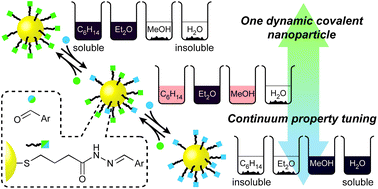当前位置:
X-MOL 学术
›
Chem. Sci.
›
论文详情
Our official English website, www.x-mol.net, welcomes your
feedback! (Note: you will need to create a separate account there.)
Continuum tuning of nanoparticle interfacial properties by dynamic covalent exchange†
Chemical Science ( IF 7.6 ) Pub Date : 2017-11-17 00:00:00 , DOI: 10.1039/c7sc03666c William Edwards 1, 2, 3 , Nicolas Marro 1, 2, 3 , Grace Turner 1, 2, 3 , Euan R. Kay 1, 2, 3
Chemical Science ( IF 7.6 ) Pub Date : 2017-11-17 00:00:00 , DOI: 10.1039/c7sc03666c William Edwards 1, 2, 3 , Nicolas Marro 1, 2, 3 , Grace Turner 1, 2, 3 , Euan R. Kay 1, 2, 3
Affiliation

|
Surface chemical composition is fundamental to determining properties on the nanoscale, making precise control over surface chemistry critical to being able to optimise nanomaterials for virtually any application. Surface-engineering independent of the preparation of the underlying nanomaterial is particularly attractive for efficient, divergent synthetic strategies, and for the potential to create reactive, responsive and smart nanodevices. For monolayer-stabilised nanoparticles, established methods include ligand exchange to replace the ligand shell in its entirety, encapsulation with amphiphilic (macro)molecules, noncovalent interactions with surface-bound biomolecules, or a relatively limited number of covalent bond forming reactions. Yet, each of these approaches has considerable drawbacks. Here we show that dynamic covalent exchange at the periphery of the nanoparticle-stabilizing monolayer allows surface-bound ligand molecular structure to be substantially modified in mild and reversible processes that are independent of the nanoparticle–molecule interface. Simple stoichiometric variation allows the extent of exchange to be controlled, generating a range of kinetically stable mixed-monolayer compositions across an otherwise identical, self-consistent series of nanoparticles. This approach can be used to modulate nanoparticle properties that are defined by the monolayer composition. We demonstrate switching of nanoparticle solvent compatibility between widely differing solvents – spanning hexane to water – and the ability to tune solubility across the entire continuum between these extremes, all from a single nanoparticle starting point. We also demonstrate that fine control over mixed-monolayer composition influences the assembly of discrete, colloidally stable nanoparticle clusters. By carefully assessing monolayer composition in each state, using both in situ and ex situ methods, we are able to correlate the molecular-level details of the nanoparticle-bound monolayer with system-level properties and behaviour. These empirically determined relationships contribute fundamental insights on nanoscale structure–function relationships, which are currently beyond the capabilities of ab initio prediction.
中文翻译:

通过动态共价交换连续调整纳米粒子的界面特性†
表面化学成分是决定纳米级性能的基础,因此对表面化学的精确控制对于能够针对几乎所有应用优化纳米材料至关重要。独立于底层纳米材料制备的表面工程对于高效,多样化的合成策略以及创建反应性,响应性和智能纳米设备的潜力特别有吸引力。对于单层稳定的纳米颗粒,已建立的方法包括完全替换配体壳的配体交换,两亲(大分子)包封,与表面结合的生物分子的非共价相互作用或相对有限数量的共价键形成反应。然而,这些方法中的每一种都有相当大的缺点。在这里,我们表明,在稳定纳米颗粒的单分子层周围进行动态共价交换,可以使表面结合的配体分子结构在与纳米颗粒-分子界面无关的温和且可逆的过程中得到实质性修饰。简单的化学计量变化可以控制交换的程度,从而在一系列相同的,自洽的纳米颗粒上产生一系列动力学稳定的混合单层组合物。该方法可用于调节由单层组合物定义的纳米颗粒性质。我们证明了纳米粒子溶剂兼容性在广泛不同的溶剂之间(从己烷到水)的切换,以及在这些极端之间在整个连续过程中调节溶解度的能力,所有这些都从一个纳米粒子的出发点开始。我们还证明了对混合单分子膜成分的精细控制会影响离散的,胶体稳定的纳米粒子簇的组装。通过仔细评估每种状态下的单分子层组成,同时使用两种方法在原位和异位方法中,我们能够将纳米颗粒结合的单分子层的分子水平细节与系统水平的特性和行为相关联。这些凭经验确定的关系为纳米尺度的结构-功能关系提供了基本的见识,而这些关系目前尚无从头算的能力。
更新日期:2017-11-17
中文翻译:

通过动态共价交换连续调整纳米粒子的界面特性†
表面化学成分是决定纳米级性能的基础,因此对表面化学的精确控制对于能够针对几乎所有应用优化纳米材料至关重要。独立于底层纳米材料制备的表面工程对于高效,多样化的合成策略以及创建反应性,响应性和智能纳米设备的潜力特别有吸引力。对于单层稳定的纳米颗粒,已建立的方法包括完全替换配体壳的配体交换,两亲(大分子)包封,与表面结合的生物分子的非共价相互作用或相对有限数量的共价键形成反应。然而,这些方法中的每一种都有相当大的缺点。在这里,我们表明,在稳定纳米颗粒的单分子层周围进行动态共价交换,可以使表面结合的配体分子结构在与纳米颗粒-分子界面无关的温和且可逆的过程中得到实质性修饰。简单的化学计量变化可以控制交换的程度,从而在一系列相同的,自洽的纳米颗粒上产生一系列动力学稳定的混合单层组合物。该方法可用于调节由单层组合物定义的纳米颗粒性质。我们证明了纳米粒子溶剂兼容性在广泛不同的溶剂之间(从己烷到水)的切换,以及在这些极端之间在整个连续过程中调节溶解度的能力,所有这些都从一个纳米粒子的出发点开始。我们还证明了对混合单分子膜成分的精细控制会影响离散的,胶体稳定的纳米粒子簇的组装。通过仔细评估每种状态下的单分子层组成,同时使用两种方法在原位和异位方法中,我们能够将纳米颗粒结合的单分子层的分子水平细节与系统水平的特性和行为相关联。这些凭经验确定的关系为纳米尺度的结构-功能关系提供了基本的见识,而这些关系目前尚无从头算的能力。











































 京公网安备 11010802027423号
京公网安备 11010802027423号